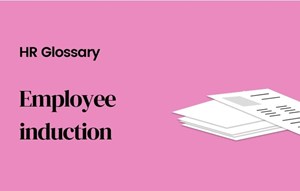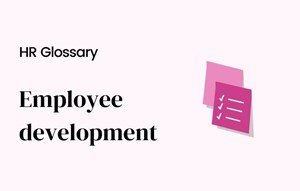Employee Retention

[Sommaire]
What is employee retention?
Employee retention is the extent to which an organization keeps or ‘retains’ its employees. It could be said to be the opposite of employee turnover. Employee retention strategies are expressed using a stability index, indicating longer-term employees who remain employed.
Due to the importance of employee retention, organizations often invest time and money into minimizing unwanted employee turnover and ensuring professional development.
Why does employee retention matter?
Successful employee retention programs are important to organizations because they indicate employee engagement levels. If employees enjoy working somewhere and are given the proper support and opportunities, they are more likely to stay. Therefore, employee retention can be used as a KPI for employee satisfaction and engagement.
To retain employees, there are several reasons that the employers should take note of :
- It can save an organization money. The cost of recruiting and training new employees can be high.
- It can help to maintain continuity and stability within an organization.
- It can improve performance as employees become more experienced and familiar with their roles.
- It can help to build a strong employer brand, making it easier to attract new employees.
Generally, with increased job satisfaction and engaged employees, an organization will typically experience :
- Better productivity
- Lower absence
- Reduced costs.
What causes high employee turnover?
There are several reasons why employees may choose to leave an organization, including:
Poor management :
Employees may leave if they feel that their managers are not good at their jobs or if they do not feel supported by management.
Lack of development opportunities:
Employees may become frustrated if they feel that they are not being given the opportunity to develop and progress in their careers.
Poor work/life balance:
If an organization does not offer a healthy work/life balance, employees may become stressed and overworked, leading to a high departing employee rate.
Poor pay and benefits:
If employees feel they are not being paid fairly or their benefits are not good, they may seek a job elsewhere with competitive compensation in the job market.
Lack of recognition:
If employees feel their hard work is not being recognized or appreciated, they may start looking for a new job.
Bullying or harassment:
If an employee is being bullied or harassed at work, they may feel that they have no choice but to leave.
Unhappy with the company culture:
If an employee is not happy with the company culture, they may look for a job with a better fit.
How do you calculate the employee retention rate?
The stability index allows managers to calculate the employee retention rate. This is calculated as follows :
The number of people employed over the stated time period ÷ number of people employed at the start of the stated time period x 100 = retention.
For instance, if you have 79 people employed over a year and 81 employed at the start of that period, your retention figure would be 97.5%.
(79 ÷ 81) x 100 = 97.5%.
It is important to include the correct number of employees in your figures. Only individuals who have been employed during the entire time period should be included. You should exclude people who were hired or left part-way through.
How can you increase employee retention?
There are several steps an organization can take to improve employee retention strategy. Many of these focus on strengthening company culture and improving employee engagement to reduce employee turnover. Some ideas include :
Communicating a clear purpose and vision
Employees who work for an organization with a clear and attractive purpose are more likely to stay with their employer. Many companies have a strong vision or mission but do not successfully articulate it to their employees.
Taking time to communicate your purpose and ensuring your employees understand how their role contributes to this purpose can help improve retention.
Investing in career development
Many talented employees leave companies because they feel their careers would improve by moving to another organization.
By working with valuable employees to identify a clear career path and then supporting them with training and development to achieve their goals, you can reduce the chance of those employees leaving to go to another company.
Provide flexible work
Many employees leave to work for employers who allow them a better work-life balance. Flexible working can be easy to implement yet mean a lot to employees.
Manager training and development
‘People do not leave companies; they leave managers.’ Managers are at the frontline of employee engagement, and your organization will suffer if they do not have the skill sets needed to support employees and motivate them to do their best.
Consider reviewing the way you promote experts into manager positions – are they really the best people to become people managers?
Creating a strong reward and recognition program
Employees who feel appreciated are less likely to leave. By implementing a cohesive reward and recognition program that works at all levels of your organization and for all sorts of work, you will start to see improved retention.
What are the employee retention models?
1. Maslow's hierarchy of needs:
One of the most famous theories in psychology is Maslow's Hierarchy of Needs. This theory suggests that people are motivated to satisfy basic needs such as food and shelter before moving on to higher-level needs such as belonging and self-esteem.
This theory can be applied to employee retention by understanding what needs employees are trying to satisfy at work.
If their basic needs are not satisfied, they will be more likely to leave. Conversely, if their higher-level needs are not being met, they may also look for a job to better meet them.
2. McClelland's theory of motivation:
McClelland's theory of motivation suggests that people are motivated by three main needs: achievement, power, and affiliation.
This theory can be applied to employee retention by understanding what motivates employees and ensuring that their jobs fulfill those needs.
For example, if an employee is motivated by a need for achievement, they may be more likely to stay with a company if their job allows them to accomplish tasks and goals.
3. Herzberg's two-factor theory:
Herzberg's two-factor theory suggests that two main factors affect motivation: hygiene factors and motivators. Hygiene factors are things like salary and working conditions, while motivators are things like challenge and opportunity.
This theory can be applied to employee retention by ensuring that the hygiene factors and the motivators are present in the workplace. Employees may be more likely to leave if one of these is lacking.
4. Argyris' theory of employee motivation:
Argyris' theory of employee motivation suggests that there are two types of motivation: intrinsic and extrinsic. Intrinsic motivation comes from within the employee, while extrinsic motivation comes from external factors such as rewards or punishments.
This theory can be applied to employee retention by ensuring that employees are motivated internally and externally. If employees are only motivated by external factors, they may be more likely to leave when those factors are no longer present.
5. Vroom's expectancy theory:
Vroom's expectancy theory suggests that people are motivated by three main things: expectancy, instrumentality, and valence.
Expectancy is the belief that effort will lead to performance, instrumentality is the belief that performance will lead to rewards, and valence is the value of those rewards.
This theory can be applied to employee retention by ensuring that employees believe their efforts will be rewarded.


